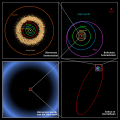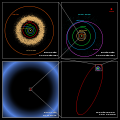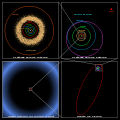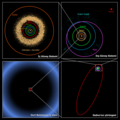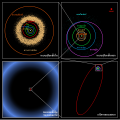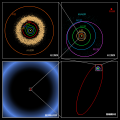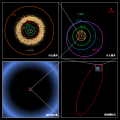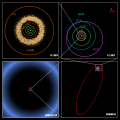File:Oort cloud Sedna orbit-ca.svg

Original file (SVG file, nominally 2,499 × 2,499 pixels, file size: 700 KB)
Captions
Captions
| This SVG file contains embedded text that can be translated into your language, using any capable SVG editor, text editor or the SVG Translate tool. For more information see: About translating SVG files. |
Summary
edit| DescriptionOort cloud Sedna orbit-ca.svg |
Català: Aquests quatre panells mostren la ubicació de l'objecte transneptunià (90377) Sedna, que es troba en els confins del sistema solar.[1] ada panell, movent-se en sentit horari des de la part superior esquerra, successivament s'allunya per col·locar Sedna en el seu context.
El primer panell mostra les òrbites dels planetess interiors i Júpiter; i el cinturó d'asteroides. En el segon panell, Sedna es mostra també fora de les òrbites de Neptú i els objectes del Cinturó de Kuiper. L'òrbita completa de Sedna s'il·lustra en el tercer panell, juntament amb la ubicació de l'objecte en l'any 2004, arribant al seu màxim acostament al Sol. L'últim panell s'allunya molt més, que mostra que fins i tot aquesta gran òrbita el·líptica que rau dins del que es creu que és la vora interior del núvol d'Oort esfèric: una distribució de cossos gelats i freds situats en els límits de l'atracció gravitacional del Sol. La presència de Sedna suggereix que el disc intern prèviament especulat sobre l'eclíptica sí que existeix.English: These four panels show the location of trans-Neptunian object 90377 Sedna, which lies in the farthest reaches of the Solar system.[2] Each panel, moving clockwise from the upper left, successively zooms out to place Sedna in context.
The first panel shows the orbits of the inner planets and Jupiter; and the asteroid belt. In the second panel, Sedna is shown well outside the orbits of Neptune and the Kuiper belt objects. Sedna's full orbit is illustrated in the third panel along with the object's location in 2004, nearing its closest approach to the Sun. The final panel zooms out much farther, showing that even this large elliptical orbit falls inside what was previously thought to be the inner edge of the spherical Oort cloud: a distribution of cold, icy bodies lying at the limits of the Sun's gravitational pull. Sedna's presence suggests that the previously speculated inner disk on the ecliptic does exist. |
| Date | March 15, 2004 (original image), August 2006 (SVG conversion) |
| Source | SVG version of Image:Oort cloud Sedna orbit.jpg, which lists the following sources: [1] [2] Splitzer Space Telescope Released Images about Sedna |
| Author |
|
| Permission (Reusing this file) |
Public domain, see below |
| Other versions |
[edit]
|
- ↑ Most Distant Object in Solar System Discovered. Press release: Jet Propulsion Laboratory. March 15, 2004.
- ↑ Most Distant Object in Solar System Discovered. Press release: Jet Propulsion Laboratory. March 15, 2004.
| This is a retouched picture, which means that it has been digitally altered from its original version. Modifications: This image is based on http://commons.wikimedia.org/wiki/File:Oort_cloud_Sedna_orbit.jpg remade as an SVG to allow easy translation to other languages and addition of future changes.. The original can be viewed here: Oort cloud Sedna orbit.jpg:
|
Licensing
edit| Public domainPublic domainfalsefalse |
| This file is in the public domain in the United States because it was solely created by NASA. NASA copyright policy states that "NASA material is not protected by copyright unless noted". (See Template:PD-USGov, NASA copyright policy page or JPL Image Use Policy.) |  | |
 |
Warnings:
|
File history
Click on a date/time to view the file as it appeared at that time.
| Date/Time | Thumbnail | Dimensions | User | Comment | |
|---|---|---|---|---|---|
| current | 16:37, 24 April 2013 |  | 2,499 × 2,499 (700 KB) | Manlleus (talk | contribs) | User created page with UploadWizard |
You cannot overwrite this file.
File usage on Commons
The following 26 pages use this file:
- File:Oort-wolk Sedna wentelbaan.svg
- File:Oort cloud Sedna orbit-ar.png
- File:Oort cloud Sedna orbit-br.svg
- File:Oort cloud Sedna orbit-ca.svg
- File:Oort cloud Sedna orbit-de.svg
- File:Oort cloud Sedna orbit-fr.svg
- File:Oort cloud Sedna orbit-lb.svg
- File:Oort cloud Sedna orbit-no.svg
- File:Oort cloud Sedna orbit-sv.svg
- File:Oort cloud Sedna orbit-th.svg
- File:Oort cloud Sedna orbit-tr.png
- File:Oort cloud Sedna orbit-vi.svg
- File:Oort cloud Sedna orbit.jpg
- File:Oort cloud Sedna orbit.svg
- File:Oort cloud Sedna orbit af.svg
- File:Oort cloud Sedna orbit french.jpg
- File:Oort cloud Sedna orbit mk.svg
- File:Oort cloud Sedna orbit pt.svg
- File:Oort cloud Sedna orbit ru.svg
- File:Oort cloud Sedna orbit sv.svg
- File:Oort cloud Sedna orbit ua.svg
- File:Oort cloud Sedna orbit uk.jpg
- File:Oort cloud Sedna orbit zh-cn.svg
- File:Oort cloud Sedna orbit zh-hk.svg
- File:Oort cloud Sedna orbit zh-tw.svg
- Template:Other versions/Oort cloud Sedna orbit
File usage on other wikis
The following other wikis use this file:
- Usage on ca.wikipedia.org
Metadata
This file contains additional information such as Exif metadata which may have been added by the digital camera, scanner, or software program used to create or digitize it. If the file has been modified from its original state, some details such as the timestamp may not fully reflect those of the original file. The timestamp is only as accurate as the clock in the camera, and it may be completely wrong.
| Width | 2499 |
|---|---|
| Height | 2499 |
